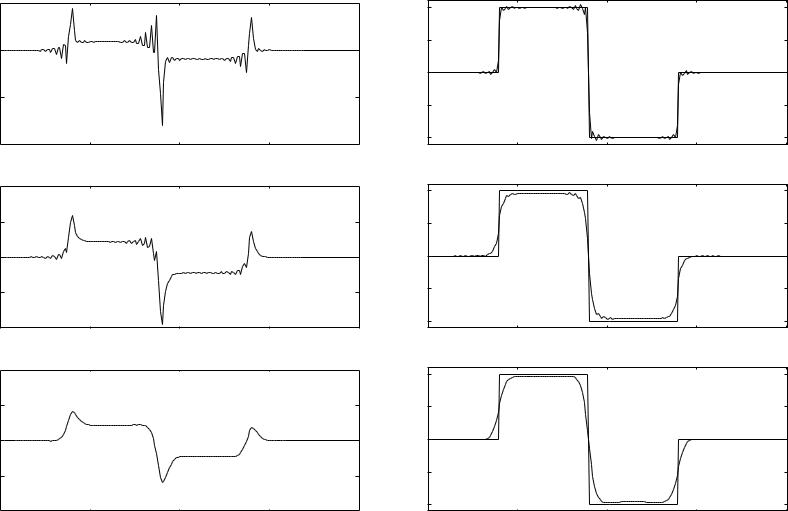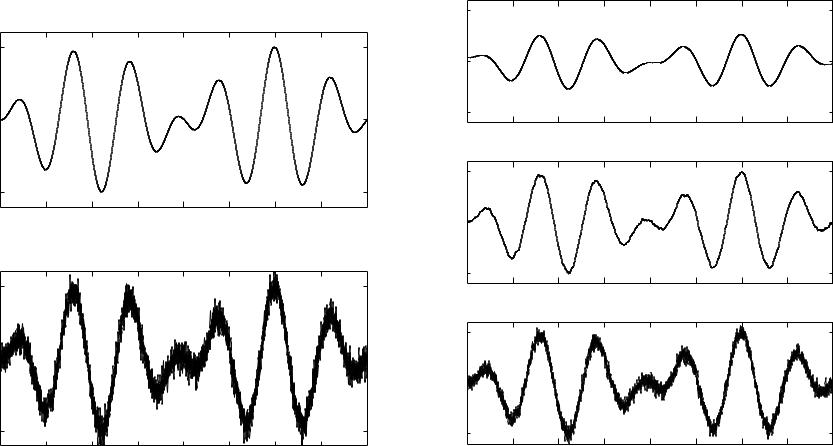
[Boyd]_cvxslides
.pdf
example (m = 100, n = 30): histogram of residuals for penalties |
|||||
φ(u) = |u|, |
φ(u) = u2, |
φ(u) = max{0, |u|−a}, |
φ(u) = − log(1−u2) |
||
|
40 |
|
|
|
|
p = 1 |
|
|
|
|
|
|
0 |
|
|
|
|
|
−2 |
−1 |
0 |
1 |
2 |
p = 2 |
10 |
|
|
|
|
|
|
|
|
|
|
|
0 |
|
|
|
|
Deadzone |
−2 |
−1 |
0 |
1 |
2 |
20 |
|
|
|
|
|
0 |
|
|
|
|
|
|
|
|
|
|
|
Log barrier |
−2 |
−1 |
0 |
1 |
2 |
10 |
|
|
|
|
|
0 |
|
|
|
|
|
|
|
|
|
|
|
|
−2 |
−1 |
0 |
1 |
2 |
|
|
|
r |
|
|
shape of penalty function has large e ect on distribution of residuals
Approximation and fitting |
6–5 |

Huber penalty function (with parameter M)
|
M(2|u| − M) |u| > M |
|
φhub(u) = |
u2 |
|u| ≤ M |
linear growth for large u makes approximation less sensitive to outliers
|
2 |
|
|
|
|
|
|
|
|
|
|
|
|
|
20 |
|
|
|
|
|
1.5 |
|
|
|
|
|
|
|
|
) |
|
|
|
|
10 |
|
|
|
|
(u |
1 |
|
|
|
) |
|
|
|
|
hub |
|
|
|
0 |
|
|
|
|
|
|
|
|
|
|
|
|
|
||
|
|
|
|
t(f |
|
|
|
|
|
φ |
|
|
|
|
|
|
|
|
|
|
0.5 |
|
|
|
−10 |
|
|
|
|
|
|
|
|
|
|
|
|
|
|
|
0 |
|
|
|
−20 |
|
|
|
|
|
−1.5 −1 −0.5 0 |
0.5 |
1 |
1.5 |
−10 |
−5 |
0 |
5 |
10 |
|
u |
|
|
|
|
|
t |
|
|
•left: Huber penalty for M = 1
•right: a ne function f(t) = α + βt fitted to 42 points ti, yi (circles) using quadratic (dashed) and Huber (solid) penalty
Approximation and fitting |
6–6 |
Least-norm problems
minimize |
kxk |
subject to |
Ax = b |
(A Rm×n with m ≤ n, k · k is a norm on Rn)
interpretations of solution x = argminAx=b kxk:
•geometric: x is point in a ne set {x | Ax = b} with minimum distance to 0
•estimation: b = Ax are (perfect) measurements of x; x is smallest (’most plausible’) estimate consistent with measurements
•design: x are design variables (inputs); b are required results (outputs) x is smallest (’most e cient’) design that satisfies requirements
Approximation and fitting |
6–7 |
examples
•least-squares solution of linear equations (k · k2): can be solved via optimality conditions
2x + AT ν = 0, Ax = b
• minimum sum of absolute values (k · k1): can be solved as an LP
minimize |
1T y |
subject to |
−y x y, Ax = b |
tends to produce sparse solution x |
|
extension: least-penalty problem |
|
minimize |
φ(x1) + · · · + φ(xn) |
subject to |
Ax = b |
φ : R → R is convex penalty function
Approximation and fitting |
6–8 |
Regularized approximation
minimize (w.r.t. R2+) (kAx − bk, kxk)
A Rm×n, norms on Rm and Rn can be di erent
interpretation: find good approximation Ax ≈ b with small x
•estimation: linear measurement model y = Ax + v, with prior knowledge that kxk is small
•optimal design: small x is cheaper or more e cient, or the linear model y = Ax is only valid for small x
•robust approximation: good approximation Ax ≈ b with small x is less sensitive to errors in A than good approximation with large x
Approximation and fitting |
6–9 |
Scalarized problem
minimize kAx − bk + γkxk
•solution for γ > 0 traces out optimal trade-o curve
•other common method: minimize kAx − bk2 + δkxk2 with δ > 0
Tikhonov regularization
minimize kAx − bk22 + δkxk22
can be solved as a least-squares problem
|
|
|
|
|
|
|
|
A |
|
b |
|
2 |
||
|
|
|
|
|
|
|
|
|
||||||
|
|
|
|
|
|
|
|
|
|
|
||||
|
|
|
|
|
|
|
|
|
|
|
|
|
||
|
|
|
|
minimize |
|
√ |
δI |
x − |
0 |
2 |
||||
solution x |
|
= (A |
T |
A + δI) |
−1 |
A |
T |
|
|
|
|
|
|
|
|
|
|
b |
|
|
|
|
|
|
|
||||
Approximation and fitting |
6–10 |
Optimal input design
linear dynamical system with impulse response h:
Xt
|
y(t) = |
h(τ)u(t − τ), t = 0, 1, . . . , N |
|
|
|
|
|||||||
|
τ=0 |
|
|
|
|
|
|
|
|
|
|
|
|
input design problem: multicriterion problem with 3 objectives |
|
|
|
||||||||||
1. |
tracking error with desired output ydes: Jtrack = |
N |
(y(t) |
|
y |
|
(t))2 |
||||||
2. |
input magnitude: Jmag = |
N |
u(t)2 |
|
|
Pt=0 |
|
− |
|
des |
|
||
|
|
|
t=0 |
|
|
|
|
|
|
|
|
|
|
3. |
input variation: Jder = |
|
N−1 |
(u(t + 1) |
|
u(t))2 |
|
|
|
|
|
|
|
|
P |
− |
|
|
|
|
|
|
|||||
|
|
|
t=0 |
|
|
|
|
|
|
|
|
|
|
P
track desired output using a small and slowly varying input signal regularized least-squares formulation
minimize Jtrack + δJder + ηJmag
for fixed δ, η, a least-squares problem in u(0), . . . , u(N)
Approximation and fitting |
6–11 |

example: 3 solutions on optimal trade-o surface
(top) δ = 0, small η; (middle) δ = 0, larger η; (bottom) large δ
|
5 |
|
|
|
|
u(t) |
0 |
|
|
|
|
−5 |
|
|
|
|
|
|
|
|
|
|
|
−100 |
50 |
100 |
150 |
200 |
|
|
4 |
|
t |
|
|
|
|
|
|
|
|
|
2 |
|
|
|
|
(t) |
0 |
|
|
|
|
u |
|
|
|
|
|
|
−2 |
|
|
|
|
|
−40 |
50 |
100 |
150 |
200 |
|
4 |
|
t |
|
|
|
|
|
|
|
|
|
2 |
|
|
|
|
(t) |
0 |
|
|
|
|
u |
|
|
|
|
|
|
−2 |
|
|
|
|
|
−40 |
50 |
100 |
150 |
200 |
|
|
|
t |
|
|
Approximation and fitting
|
1 |
|
|
|
|
(t) |
0.5 |
|
|
|
|
0 |
|
|
|
|
|
y |
|
|
|
|
|
−0.5 |
|
|
|
|
|
|
−1 |
|
|
|
|
|
0 |
50 |
100 |
150 |
200 |
|
1 |
|
t |
|
|
|
|
|
|
|
|
(t) |
0.5 |
|
|
|
|
0 |
|
|
|
|
|
y |
|
|
|
|
|
−0.5 |
|
|
|
|
|
|
−1 |
|
100 |
|
200 |
|
0 |
50 |
150 |
||
|
1 |
|
t |
|
|
|
|
|
|
|
|
(t) |
0.5 |
|
|
|
|
0 |
|
|
|
|
|
y |
|
|
|
|
|
−0.5 |
|
|
|
|
|
|
−1 |
|
|
|
|
|
0 |
50 |
100 |
150 |
200 |
|
|
|
t |
|
|
|
|
|
|
|
6–12 |
Signal reconstruction
minimize (w.r.t. R2+) (kxˆ − xcork2, φ(ˆx))
•x Rn is unknown signal
•xcor = x + v is (known) corrupted version of x, with additive noise v
•variable xˆ (reconstructed signal) is estimate of x
•φ : Rn → R is regularization function or smoothing objective
examples: quadratic smoothing, total variation smoothing:
n−1 |
n−1 |
X |
X |
φquad(ˆx) = (ˆxi+1 − xˆi)2, |
φtv(ˆx) = |xˆi+1 − xˆi| |
i=1 |
i=1 |
Approximation and fitting |
6–13 |

quadratic smoothing example
|
|
|
|
|
|
0.5 |
|
|
|
|
0.5 |
|
|
|
|
xˆ |
0 |
|
|
|
|
|
|
|
|
|
|
|
|
|
||
x 0 |
|
|
|
|
−0.5 |
|
|
|
|
|
|
|
|
|
|
|
|
|
|
|
|
|
|
|
|
|
|
0 |
1000 |
2000 |
3000 |
4000 |
|
|
|
|
|
|
0.5 |
|
|
|
|
−0.5 |
|
|
|
|
|
|
|
|
|
|
0 |
1000 |
2000 |
3000 |
4000 |
xˆ |
0 |
|
|
|
|
0.5 |
|
|
|
|
−0.5 |
|
|
|
|
|
|
|
|
|
|
0 |
1000 |
2000 |
3000 |
4000 |
|
|
|
|
|
|
|
|||||
cor 0 |
|
|
|
|
|
0.5 |
|
|
|
|
|
|
|
|
|
|
|
|
|
|
|
x |
|
|
|
|
xˆ |
0 |
|
|
|
|
−0.5 |
|
|
|
|
−0.5 |
|
|
|
|
|
0 |
1000 |
2000 |
3000 |
4000 |
|
0 |
1000 |
2000 |
3000 |
4000 |
|
|
i |
|
|
|
|
|
i |
|
|
|
original signal x and noisy |
|
|
three solutions on trade-o curve |
||||||
|
|
signal xcor |
|
|
|
|
kxˆ − xcork2 versus φquad(ˆx) |
|
||
Approximation and fitting |
6–14 |
